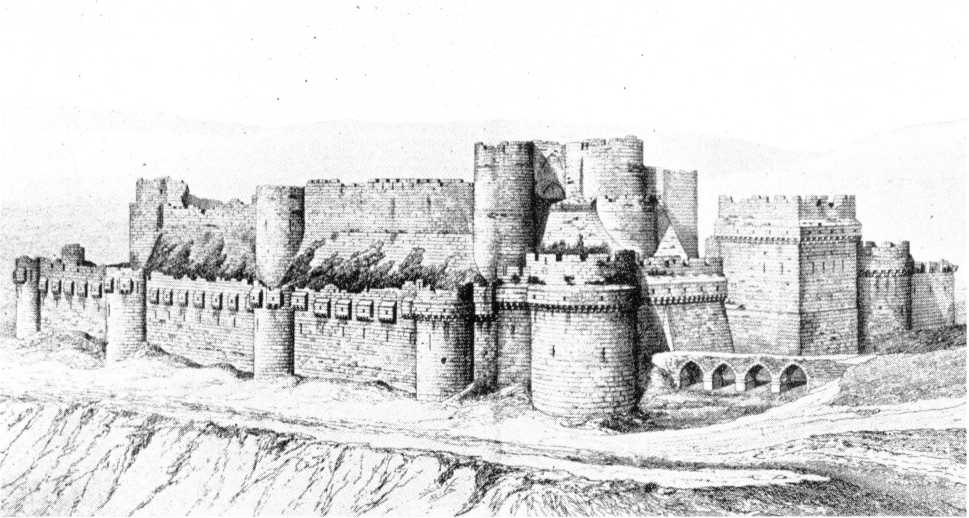m754

The famous Krak des Chevaliers, manned by the Knights Hospitaller from 1142 until its capture in 1272. Because of their relatively smali numbers, the Franks were dependent on such fortifications to maintain control of their lands. Such castles were built for economic and administrative purposes just as much as for military ones, and the Krak controlled the lands of the Assassins, who paid tribute to the Hospitallers. The garrison and Staff at such a centre of power could be as large as 2000—the population of a major town in Europę.
a type of sword which was prevalent in all Islamie armies.
E4 Moorish horseman, late i2th century The heart-shaped shield (adarga) of the Moorish cavalry first appears in Spain during the late i2th-century invasion by the Berbers. It was madę of several layers of hardened leather sewn together. The style was copied by the Spaniards, just as the Moors’ styles were influenced by those of the West; lor example, Moorish cavalry also used the flat-topped version of the kite-shaped shield in the second half of the 13th century. Light cavalrymen, such as the one illustrated, did not normally wear hclmets, but wore a variety of soft head-gear. Heavy cavalry generally wore helmets and mail hauberks and the latter were not reinforced by piąte armour as in the Holy Land (see Plates G and H).
Fi Byzantine peltast early i2th century The Byzantine infantryman known as a ‘peltast’ first appeared in the ioth century and is recorded in the early i2th century by Anna Comnena, daugh-ter of the emperor. He was probably an economy measure, being better armed than the light infantry of the older empire, but not so heavily armoured as the old heavy infantry.
A corselet of lamellar armour may have been worn in earlier times, but lack of funds in the i i tli and 12th centuries would probably have resultcd in the men wearing the thickly quilted and studded armour illustrated. (Lamellar armour consisted of smali rectangular plates of iron or rawhide laced together with leather thongs in horizontal rows, the rows then being laced together vertically, over-lapping each other upwards.) The kite-shaped shield may have been Byzantine in origin.
F2 Yarangian guardsman Late nth century This figurę is based on a mosaic at the Church of Nea Moni on the island of Khios. By the time of the crusadcs the Varangian Guard was the most important and most loyal part of the standing army. It consisted almost entirely of Anglo-Saxons,
Wyszukiwarka
Podobne podstrony:
Named after the Roman city of Pompeii, whkh was buried by lava and ashes from thevolcano Mount Ve$uv
Flower poem Flowers are one of the most beautiful things on earth. Picture yourself in a field fuli
Czy demokracja przeżyje?AFTER-TAX RATĘ OF RETURN VS. GROWTH RATĘ AT THE WORLD LEVEL, FROM ANTIQUITY
mbs 069 M BREATHING >Y>IKM phy.sicai culture, it is no wonder that the death-rate from consump
82 2 M@@8 The moose is the largest member ofthe deer family and Itoes in many regions of northem Nor
1972 Nations Unieś — Recueil des Traites 103 by the first-mentioned State; such tax may not, ho
ownrd by thc lulian Sratc, eicher in acs own narnc ot in «hc rurne of the lulian administration in E
więcej podobnych podstron